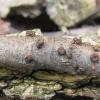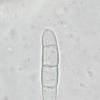
24-12-2025 17:08
Hulda Caroline HolteHello, I have found this propoloid ascomycete on

21-12-2025 09:32
Hello.A tiny ascomycete found embedded in wood in

21-12-2025 21:32
Pol DebaenstHello, Garden, Burgweg 19, Veurne, BelgiumOn 10/1

22-12-2025 23:38
Patrice TANCHAUDBonsoir, récolte sur un mur en pierre, apothéci

22-12-2025 00:47
Patrice TANCHAUDBonsoir, récolte à proximité du milieu dunaire
I found this Nectria species, which belongs to the N. cinnabarina complex. The dark colour was remarkable for me. Analyzing the spores I found several of it with three septa. So I thought this was N. cinnabarina s. str. But after further search I also found two spores with four septa. According to the key of Hirooka, Rossman and Chaverri: "A morphological and phylogenetic revision of the Nectria cinnabarina species complex" this is Nectria nigrescens.
The name suggests a blackening behavior of the species. But this is not described for this species. The normal colours are brighter like in N. cinnabarina but all species, including N. dematiosa can be more or less darker. The dried sporodochia seem to be darker than the fresh ones. Some of them are black now.
Am I right with N. nigrescens? Are there new scientific findings? Is this a rare or overlooked species?
Sporodochia: short stipitate to sessile, dark red brown, seem to blacken when dried
Ascospores: 12-16 (19) x 4-5,5 µm, mostly 1, sometimes 0 or 2 septate, rarely 3 septate
Best regards
Steffen
can anybody confirm or refute Nectria nigrescens or suggest another species?
Regards
Steffen


